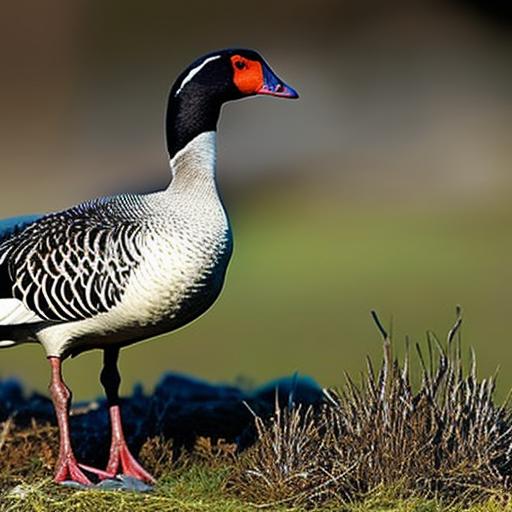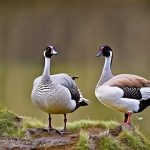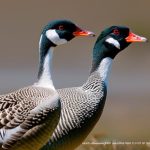Raising English geese can be a rewarding and enjoyable experience for anyone interested in poultry farming. English geese are known for their gentle nature, excellent foraging abilities, and high-quality meat and eggs. They are also popular for their beautiful plumage and are often kept for ornamental purposes as well. Whether you are a small-scale hobbyist or a commercial farmer, raising English geese can be a profitable venture. In this article, we will explore the popular breeds of English geese, their characteristics, housing and care requirements, feeding and nutrition needs, common health issues, and breeding and raising goslings.
Popular Breeds of English Geese
There are several popular breeds of English geese, each with its own unique characteristics and qualities. The Embden goose is one of the most popular breeds, known for its large size, white plumage, and calm temperament. Toulouse geese are another popular breed, prized for their excellent meat production and gentle nature. The Pilgrim goose is a unique breed in which males and females can be easily distinguished by their plumage color, making them popular for backyard breeders. The Sebastopol goose is known for its curly feathers, making it a favorite among ornamental breeders. Other popular breeds include the African goose, Chinese goose, and Buff goose. Each breed has its own specific traits and qualities, so it’s important to research and choose the breed that best suits your needs and preferences.
Characteristics of English Geese
English geese are known for their gentle and docile nature, making them easy to handle and care for. They are excellent foragers and can thrive on pasture-based diets, making them well-suited for free-range farming systems. English geese are also known for their high-quality meat, which is lean and flavorful, making it a popular choice among consumers. They are also good egg layers, with some breeds laying up to 50 eggs per year. English geese come in a variety of plumage colors, including white, gray, buff, and pied, making them a visually appealing addition to any farm or backyard.
Housing and Care for English Geese
When it comes to housing and caring for English geese, it’s important to provide them with a safe and comfortable environment. A spacious coop or shelter is essential to protect them from predators and the elements. The coop should be well-ventilated and provide ample space for the geese to move around. Bedding material such as straw or wood shavings should be provided to keep the coop clean and dry. Access to fresh water is crucial for geese, as they require a lot of water for drinking and bathing. A secure fencing system is also necessary to keep the geese contained and safe from predators. Regular grooming and health checks are important to ensure the well-being of the geese.
Feeding and Nutrition for English Geese
Feeding and nutrition play a crucial role in the health and productivity of English geese. A balanced diet is essential to meet their nutritional needs and support their growth and development. Geese should have access to a variety of grasses, plants, and insects for foraging, as well as a commercial feed that is specifically formulated for waterfowl. The feed should contain a balanced mix of protein, carbohydrates, vitamins, and minerals to support their overall health. Fresh water should be available at all times, as geese require a lot of water for digestion and hydration. It’s important to monitor their feed intake and adjust their diet as needed based on their age, activity level, and seasonal changes.
Health and Common Issues for English Geese
Like any livestock, English geese are susceptible to various health issues that can affect their well-being. Common health problems include respiratory infections, parasites, bumblefoot, and nutritional deficiencies. It’s important to observe the geese regularly for any signs of illness or injury and seek veterinary care if needed. Providing a clean and sanitary living environment, regular grooming, and a balanced diet can help prevent many health issues. Parasite control is also important to keep the geese healthy, so regular deworming and parasite prevention measures should be implemented. Proper vaccination protocols should be followed to protect the geese from common diseases.
Breeding and Raising Goslings
Breeding and raising goslings can be a rewarding aspect of raising English geese. Breeding should be carefully planned to ensure genetic diversity and desirable traits in the offspring. Geese typically reach sexual maturity at around 2 years of age, at which point they can begin breeding. A ratio of one gander to three or four geese is recommended for successful breeding. Geese are seasonal breeders, with mating typically occurring in the spring months. Once the eggs are laid, they can be collected and placed in an incubator or left with the mother goose to hatch naturally. Goslings should be provided with a warm and safe brooding area with access to food and water. Proper nutrition and care are essential for the healthy growth and development of goslings.
In conclusion, raising English geese can be a fulfilling endeavor for anyone interested in poultry farming. With proper housing, care, feeding, and health management, English geese can thrive and provide high-quality meat and eggs. Breeding and raising goslings can also be an enjoyable aspect of raising geese. Whether you are a small-scale hobbyist or a commercial farmer, English geese can be a valuable addition to any farm or homestead. By understanding their characteristics, needs, and requirements, you can successfully raise healthy and productive English geese.
Meet Walter, the feathered-friend fanatic of Florida! Nestled in the sunshine state, Walter struts through life with his feathered companions, clucking his way to happiness. With a coop that’s fancier than a five-star hotel, he’s the Don Juan of the chicken world. When he’s not teaching his hens to do the cha-cha, you’ll find him in a heated debate with his prized rooster, Sir Clucks-a-Lot. Walter’s poultry passion is no yolk; he’s the sunny-side-up guy you never knew you needed in your flock of friends!







